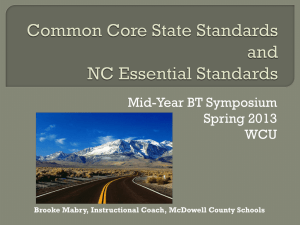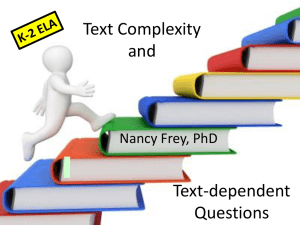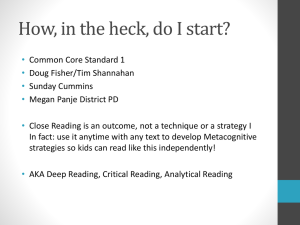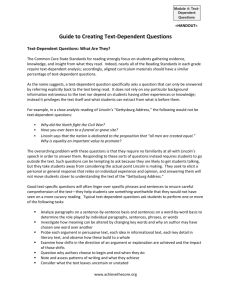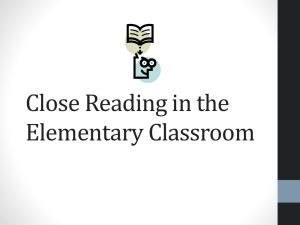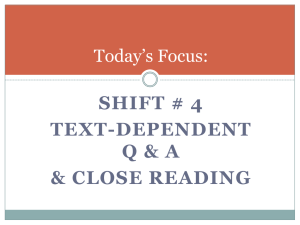Implementation of Close Reading with Secondary ELLs
advertisement
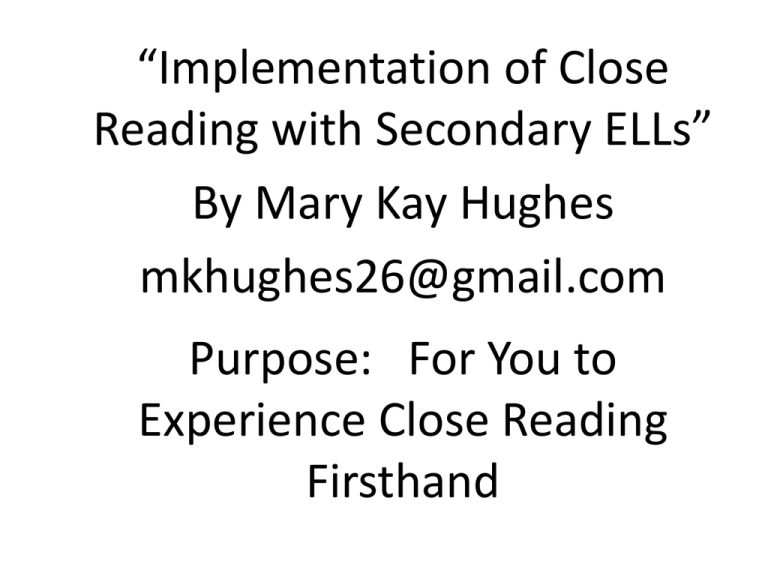
“Implementation of Close Reading with Secondary ELLs” By Mary Kay Hughes mkhughes26@gmail.com Purpose: For You to Experience Close Reading Firsthand Session Description • Guided experience close reading process. • It is a “hands-on” session. • Active participation is required for you to maximize your learning. •You will leave with 3 gifts for your efforts! Experiential understanding of close reading Understanding of textdependent questions Handouts to help you delve deeper into close reading with complex texts The following quote is from the “Revised Publishers’ Criteria for the Common Core State Standards in English Language Arts (ELA) and Literacy, Grades 3-12” “Reading well means getting the maximum insight and knowledge possible from each source.” Read closely to determine what the text says explicitly and to make inferences from it (College and Career Readiness Anchor Standards for Reading, CCSS, p. 35). The Common Core Reading Standards expect secondary students to: • Determine themes or central ideas in a text • Analyze the development of themes over the course of the text • Determine the meanings of words and phrases as they are used in a text • Delineate and evaluate the argument and specific claim in a text • Assess whether the reasoning is valid and the evidence is relevant and sufficient • Analyze and evaluate the effectiveness of the structure an author uses in his argument Close Reading: Summary Students are expected to: • comprehend complex text and draw evidence and knowledge from it • use evidence from a text to support a spoken or written claim about the text Experience: Close Reading Rev. Dr. Martin Luther King, Jr.’s “I Have A Dream” Speech Handout: “Address to civil rights marchers in Washington, D.C. on August 28, 1963” Close Reading Experience • Read the speech silently to yourself. View Video of MLK speech A good source for the video:Top 100 Speeches http://www.americanrhet oric.com/speeches/mlkih aveadream.htm Re-read the speech For the following purposes: • Is there an emotional hook? • What theme(s) do you see? • Word choice/What uncommon language is used? • What analogy does King use in developing his argument? • Other texts referenced? • Symbolism/figurative language/repetition? What theme(s)/big ideas? Uncommon language? References to historical texts? How is argument elaborated? Structure of argument? Complex text/symbolism/ prior knowledge? Summary: Close Reading Used to help you understand and learn from complex texts—difficult texts with multiple layers of meaning Text-Dependent Questions • In the article “Engaging the Adolescent Learner” by Fisher and Frey, read the subsection on the st back of the 1 page entitled “Text-Dependent Questions” (handout). Example of TextDependent Question • Cite examples that King gives which serve to support his claim that “[the Negro ] finds himself in exile in his own land”. A non-example of a text-dependent question How do you think it would have felt to have participated in the march and to have been in the audience? Example or Non-example of a text-dependent question? Explain the argument that Dr. King makes in his speech and tell which U.S. historical documents he cites to build his case. • Turn-to a partner and explain the difference between a textdependent question and a non-text-dependent question Write your own textdependent question based on King’s speech. Resources Cited/Used: • www.corestandards.org websiteResources • www.youtube.com/user/fisherandfre y (Also, search Sadlier -Close Reading by Frey on Youtube.) • Erdmann, Richard and Christine Drew, live webinar on close reading, December 14, 2012. Part of a Colville School District ELA training. More Resources Brown, Sheila and Lee Kappes, “Implementing the Common Core State Standards: A Primer on ‘Close Reading of Text’”, published by The Aspen Institute, October, 2012. www.aspeninstitute.org/education Fisher, Douglas and Nancy Frey, “Text Complexity and Close Readings” in “Engaging the Adolescent Learner, International Reading Association. www.reading.org. • Hess, Karen, “Teaching and Assessing Understanding of Text Structures Across Grades”, published by the National Center for the Improvement of Educational Assessment, 2006; research updated 2008. • Coleman, David and Susan Pimental, “Revised Publishers’ Criteria for the Common Core State Standards in English Language Arts and Literacy, Grades 3-12. www.commoncore.org/resources • Boyles, Nancy, “Closing in on Close Reading” in Educational Leadership, Dec 2012/Jan 2013. • Close Reading & Text-Dependent Questions 3-2-1 Summary • 3 Purposes of Close Reading • 2 Criteria of TextDependent Questions • 1 Definition of Close Reading • Turn-to a partner and share what you wrote (1 min. each) • Who is willing to share what they wrote with the group? •Did we meet our goals? Experiential understanding of close reading Understanding of textdependent questions Handouts to help you delve deeper into close reading with complex texts Summary of Major Shifts with the Common Core • Close Reading of Complex Text • Text-Dependent Questions • Vocabulary Acquisition • Argumentative Writing • More nonfiction Texts Evaluation • What worked well? • What could have been done differently? • What would have helped you more/improved the experience for you?
